Beijing Benz
 | |
| joint venture | |
| Industry | Automotive |
| Founded | 1984 |
| Headquarters | Beijing, China |
Area served | China |
| Products | Automobiles |
| Owner |
BAIC Motor (51%) Daimler AG (49%) |
| Parent | BAIC Motor |
| Website | www.bbac.com.cn/ |
| Beijing Benz | |||||||||||||||||
| Simplified Chinese | 北京奔驰 | ||||||||||||||||
|---|---|---|---|---|---|---|---|---|---|---|---|---|---|---|---|---|---|
| Traditional Chinese | 北京奔馳 | ||||||||||||||||
| Literal meaning | Beijing Benz | ||||||||||||||||
| |||||||||||||||||
Beijing Benz (officially Beijing Benz Automotive Co., Ltd) is an automotive manufacturing company headquartered in Beijing, China, and a joint venture between BAIC Motor and Daimler AG.[1][2]
Originally established in 1984 as Beijing Jeep Corporation (Chinese: 北京吉普汽车有限公司) by BAIC Motor with American Motors Corporation (AMC), it was the first Chinese auto-making joint venture with a Western partner. It continued after AMC was acquired by Chrysler in 1987 and after Chrysler merged with German automaker Daimler-Benz AG in 1998.
As of 2016, Beijing Benz assembles and manufactures the Mercedes-Benz E-Class (long wheelbase), and C-Class in China.[3]
History
The history of this company goes back to Beijing Jeep Corporation (BJC), which was the first Sino-foreign automobile joint venture in China.[4] It became a prototype for future cooperative projects and BJC became a test case revealing problems, both political and economic, that would appear for other investors the Chinese hoped to attract.[5]
The current name, Beijing Benz, was established in 2005 and the enterprise now owned by Beiqi and Daimler AG.[6]
American Motors
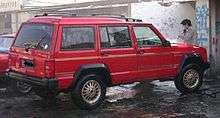
Beijing Benz grew out of what was originally the Beijing Jeep Corporation (Chinese: 北京吉普汽车有限公司), China's first Sino-western automotive joint venture having been established in 1984 with American Motors Corporation.[7]
American Motors began negotiations in 1979 to sell its vehicles in China and gain access to then low-cost Chinese labor.[8] The Chinese wanted more-modern automotive technology; Beijing Jeep suited the needs of both parties and produced the American Motors Jeep Cherokee (XJ) in Beijing.[8] While talks began in the late 1970s, operation started in 1985.[9] The initial investment by AMC was $8 million.[10] Assembly of the Cherokee continued after Chrysler purchased American Motors as did production of the classic Beijing BJ212-based SUVs.[8]
Beijing Jeep has since become well known as an example of early FDI in China.[11] Its pitfalls and successes are pored over in case studies, and such academic reports sometimes compare the marketing strategy of Beijing Jeep with that of Shanghai Volkswagen, another early Sino-foreign joint venture.[12]
Chrysler

When Chrysler purchased American Motors in 1987,[13] its Jeep brand came with an unexpected boon, Beijing Jeep. A few Chrysler models were subsequently added to the Chinese company's product line including the Jeep Grand Cherokee, Mitsubishi Pajero Sport, and the Mitsubishi Outlander, as well as some Beijing Jeep-branded, locally developed vehicles. Chrysler no longer had any ownership in Beijing Jeep as of early 2009 due to the failure of its attempt to acquire the maker of Mercedes-Benz models. That German company, Daimler, kept the profitable China manufacturing operation for itself once it was clear the merger was a failed prospect.[14] Domestic manufacture of Jeep-branded vehicles ceased in 2006.[15] Newer Jeep models are now being produced at a joint venture between Guangzhou Automobile Group and Fiat Chrysler Automobiles, current owner of the Chrysler and Jeep brands, however.[16]
Daimler AG
During Chrysler's short-lived partnership with Daimler AG, maker of Mercedes-Benz cars, production at Beijing Jeep was expanded to include Mercedes-Benz-branded products. Its legal name was changed to Beijing Benz-DaimlerChrysler Automotive Co Ltd,[7] with then German Chancellor Gerhard Schroeder in attendance at the 2004 naming ceremony.[7] While Chrysler was removed from the company in 2009, it remained in its legal name[14] for several more years.
The company started producing the Mercedes-Benz E-Class locally in 2006 and the C-Class in 2008.[17] Manufacture of Chrysler-branded models continued until at least 2008.[18] This included the 300C and Sebring, which were both locally produced and imported.[19]
Prior to 2010, the E-Class was assembled from knock-down kits with a low localization rate of about 30%.[20]
Incidentally, Daimler had previously cooperated with FAW Group to produce the then-recently discontinued Mercedes-Benz W123 (200 and 230E) sedans although these did not prove popular. Between January 1988 and sometimes in 1990, a mere 828 units were assembled in Changchun most of which were 230s.[21][22] A few dozen of the long wheelbase 230E (V123) were among the cars assembled.[22]
Operations
Beijing Benz has a production base at the Beijing Economic & Technological Development Area.[23] Another plant opened in 2010.[24] This opening may have increased potential Beijing Benz production capacity to 300,000 units/year.[18] Such unit counts may consider engines and automobiles as discrete. A future engine-making production base is scheduled to become operational in 2013.[17]
While Beijing Benz does not produce all the Mercedes-branded autos sold on the Chinese market.[25] Some Mercedes offerings, the S-Class for example, are imported by Mercedes-Benz (China) Ltd.[26]
As of 2009, Beijing Benz products, alongside those of several other makes, are purchased for use by Chinese State officials such as ministers and provincial heads.[27]
Sales in 2010 were expected to reach 50,000 cars,[24] but total Mercedes-Benz sales in China including imports were near 150,000.[17] In 2008, Beijing Benz's production capacity was estimated at 100,000 units/year[18] although that figure may consider engines and vehicles as discrete, and the company was likely able to produce only half that number of whole vehicles.
Models
Current
- Mercedes-Benz C-Class (W205 C180L, C200L, C260L, C300L, C200, C200 4MATIC, C300)
- Mercedes-Benz E-Class (V212 E180L, E200L, E260L, E320L, E400L, E400L HYBRID)
- Mercedes-Benz GLC-Class (GLC260L 4MATIC)
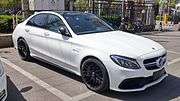
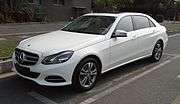

Past
- Beijing BJ212, later BJ2020/2024/2025/2032
- Jeep BJ2021/7250 Cherokee (based on the Jeep Cherokee (XJ), this was the original vehicle produced by Beijing Jeep from 1983 to 2005)[28]
- Jeep 2500/2700
- Chrysler 300C (2006-2009)
- Chrysler Sebring
- Jeep 4000/4700 (Jeep Grand Cherokee)
- Mitsubishi Pajero Sport (2003-2008)
- Mitsubishi Outlander
- Mercedes-Benz E-class (W211)
- Mercedes-Benz C-class (W204)
- Mercedes-Benz GLK-Class (2008-2016)[29] (X204 GLK200, GLK260 4MATIC, GLK300 4MATIC)
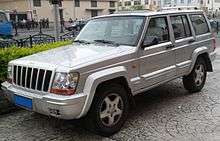

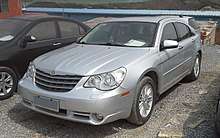



See also
References
- ↑ "Daimler Northeast Asia". Mercedes-Benz China. Retrieved 9 March 2011.
- ↑ "2009 Annual Report, 2. Significant acquisitions and dispositions of interests in companies and of other assets and liabilities". Daimler AG. Retrieved 9 March 2011.
- ↑ For assembly of vehicles, see "2009 Annual Report, 34. Related Party Relationships". Daimler AG. Retrieved 9 March 2011.
- For manufacture of vehicles, see "2009 Annual Report, 2. Significant acquisitions and dispositions of interests in companies and of other assets and liabilities". Daimler AG. Retrieved 9 March 2011.
- For models produced, see 公司介绍. Beijing Benz Automotive Co., Ltd. (in Chinese). Retrieved 2012-05-26.
- ↑ Gallagher, Kevin (2010). Handbook on Trade and the Environment. Edward Elgar Publishing. p. 152. ISBN 9781848446045. Retrieved 2 January 2018.
- ↑ Harwit, Eric (2016). China's Automobile Industry: Policies, Problems and Prospects: Policies, Problems and Prospects. Routledge. ISBN 9781315286792. Retrieved 2 January 2018.
- ↑ For pedigree, see Qiao, Yu (7 December 2004). "JV renamed Beijing Benz-DaimlerChrysler". China Daily. Retrieved 9 March 2011.
- For year established, see "Daimler Northeast Asia". Mercedes-Benz China. Retrieved 9 March 2011.
- 1 2 3 Qiao, Yu (7 December 2004). "JV renamed Beijing Benz-DaimlerChrysler". China Daily. Retrieved 9 March 2011.
- 1 2 3 Mann, Jim (1997). Beijing Jeep: A Case Study of Western Business in China. Westview Press. ISBN 978-0-8133-3327-4. Retrieved 9 March 2011.
- ↑ Doing business in China: the last great market - Page 192 Geoffrey Murray - 1994 "BEIJING JEEP Finally in this chapter, I want to return to the ongoing story of Beijing Jeep. When the first Cherokee rolled off the assembly line on 26 September 1985 - almost six years after talks on the joint venture had begun - an ..."
- ↑ Dunne, Michael J. (23 October 2008). "What Happened to Beijing Jeep? - The Car Connection". The Car Connection. Retrieved 2 January 2018.
- ↑ Needle, David (2010). Business in Context: An Introduction to Business and Its Environment (5 ed.). Cengage Learning EMEA. pp. 42–44. ISBN 978-1-84480-613-3.
- Baker, Kevin James (2007). "The Beijing Jeep and the Threat from China". Economic tsunami: China's car industry will sweep away western car makers. Rosenberg Publishing. pp. 51–63. ISBN 978-1-877058-56-1. Retrieved 27 August 2011.
- Ahlstrom, David; Bruton, Garry D. (2009). International Management: Strategy and Culture in the Emerging World. Cengage Learning. p. 164. ISBN 978-0-324-40631-3.
- ↑ Gu, Zhibin; Frank, Andre Gunder (2006). China's global reach: markets, multinationals, and globalization. Fultus. pp. 84–86. ISBN 978-1-59682-093-7.
- McGunagle, Doreen M. (2007). Romancing the big dragon: The impact of foreign entry into the Chinese automobile industry. ProQuest. p. 69. ISBN 978-0-542-99433-3.
Beijing Jeep Market Share and Capacity Utilization Chrysler's overall prices ranged from $10,613 to $55,690. Chrysler's base model of the Cherokee was $10,613. The prices were not as low as those of Shanghai VW for their basic model
- McGunagle, Doreen M. (2007). Romancing the big dragon: The impact of foreign entry into the Chinese automobile industry. ProQuest. p. 69. ISBN 978-0-542-99433-3.
- ↑ Adler, Dennis (2000). Chrysler. MotorBooks International. p. 15. ISBN 9781610608718.
- 1 2 Gao, George (17 May 2010). "Guangzhou-Fiat JV to make Chrysler Jeep in Changsha". Automotive News. gasgoo.com. Retrieved 9 March 2011.
- ↑ Ramsey, Mike; Rogers, Christina (May 9, 2013). "Chrysler's Jeep Faces Uphill Climb in China". WSJ.com. Dow Jones & Company. Retrieved 19 September 2013.
- ↑ "Marchionne Arrives Late To China Party with Fiat Viaggio". bloomberg.com. Bloomberg LP. Apr 23, 2012. Retrieved 19 September 2013.
- 1 2 3 "Daimler Expands Activities in China". Daimler AG. 28 June 2011. Retrieved 24 July 2011.
- 1 2 3 "BBDC Improves Budget Management and Keeps Pace with Fast-Changing Automotive Market" (PDF). oracle.com. November 2008. Retrieved 9 March 2011.
- ↑ "Beijing Benz-DaimlerChrysler recalls defective sedans". China Daily. Xinhua. 7 June 2007. Retrieved 9 March 2011.
- ↑ For knock-down assembly of E-Class, see "China's domestically-made Mercedes-Benz E-Class sedans to get off the line in Beijing". China Business News. Shanghai: May 31, 2010.
- For component localization rate of 30%, see Mercedes-Benz seeking higher localization rate in China globaltimes.cn, October 27, 2010 Archived July 7, 2011, at the Wayback Machine.
- ↑ Sutcliffe, Ashley (2011-06-01). "The Cherokees that sparked revolution". chinadaily.com.cn. China Daily. Retrieved 9 December 2014.
- 1 2 "比奥迪国产早1年 奔驰E级9代车型历史解析" [A year before the Audi: A history of nine generations of the Mercedes E-class] (in Chinese). www.cnfol.com. 2011-07-07. Retrieved 2014-12-11.
- ↑ For Beijing Economic & Technological Development Area, see "Daimler Northeast Asia". Mercedes-Benz China. Retrieved 9 March 2011.
- For 15kM from Daxing Caiyu, see "Part Overview". Beijing Hainachuan Automotive Parts Co., Ltd. 2008. Archived from the original on 30 April 2011. Retrieved 9 March 2011.
- 1 2 Zheng, Amanda (6 December 2010). "Beijing Benz 2010 sales expected to hit 50,000 units, up 179%". Automotive News. gasgoo.com. Retrieved 9 March 2011.
- ↑ "Motoring: Short Torque". China Daily. 20 December 2010. Retrieved 9 March 2011.
- ↑ "Mercedes-Benz S-Class is a leader in innovation". Global Times. Shanghai Daily. 1 September 2010. Retrieved 9 March 2011.
- ↑ Shasha, Deng, ed. (13 June 2009). "Chinese public revved up over BMW, Benz on gov't car list". xinhuanet.com. Archived from the original on 7 November 2012. Retrieved 9 March 2011.
- ↑ Dunne, Timothy (November 2, 2007). "Can Chrysler Rebound in China?". Business Week. Archived from the original on January 6, 2008. Retrieved 14 August 2008.
- ↑ "Beijing built Mercedes GLK pops out for pictures with minor facelift and 2.0T". chinacartimes.com. July 14, 2011. Retrieved June 22, 2012.
External links
- Beijing Benz Automotive Co., Ltd. (in Chinese)